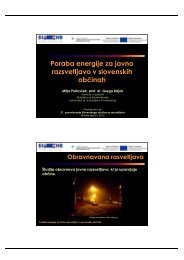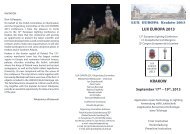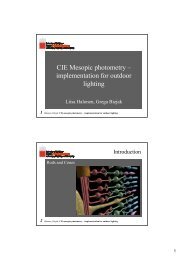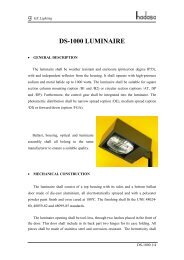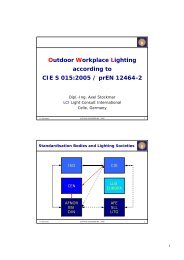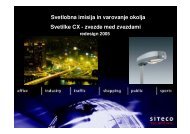Zbornik - SDR
Zbornik - SDR
Zbornik - SDR
Create successful ePaper yourself
Turn your PDF publications into a flip-book with our unique Google optimized e-Paper software.
“IEA ECBCS Annex 45 – Energy Efficient Electric Lighting for Buildings” R-2<br />
cables and damage walls. In this sense it is also possible to integrate such a system into existing<br />
buildings. On the other hand is it impossible to realize an intelligent lighting system without a lot of<br />
sensors and actuators to capture and control the environment.<br />
Directive 2000/55/EC gives energy efficiency requirements for ballasts for fluorescent lamps.<br />
The maximum power of ballast-lamp circuit, for example, of a 36 W fluorescent lamp should be less<br />
than 45 W after 21 May 2002 and less than 43 W after 21 November 2005. [6]<br />
High pressure discharge lamps are very energy-efficient lamp types. Their small discharge body<br />
allows an efficient reflector design for luminaires so that the luminous flux leaving the luminaire can<br />
be distributed effectively in the room. Typically, it takes 3 minutes to reach 80% of the nominal<br />
luminous flux of a high pressure discharge lamp. For automotive lamps, this time has been reduced<br />
to 3 seconds already [7]. At present, high pressure discharge lamps cannot replace other lamp types.<br />
Reasons are given in the start performance and in restricted dimming performance. Research on the<br />
interaction of ballast electronics and high pressure discharge lamps may significantly improve the<br />
performance of this lamp type.<br />
LEDs (Light Emitting Diodes) are new alternative light sources, which are foreseen to<br />
revolutionise the lighting technology in the near future. According to Agilent Technologies the<br />
lumens/package value of red LEDs has been increasing 30 times per decade whereas the price is<br />
decreasing 10 times per decade [8]. The use of LED based lighting could decrease the lighting energy<br />
consumption by 50 % by 2025 [9]. The future entrance of LEDs in the lighting market is dependent<br />
on improvements in conversion efficiency and optical power per package. Although most of the<br />
high-power LEDs (HP-LEDs) nowadays convert between 15 to 20% of the input power into light,<br />
their efficiency potential is far better. In fact the best AlInGaP (aluminum indium gallium phosphide)<br />
red LED and InGaN (indium gallium nitride) green and blue LEDs can have internal quantum<br />
efficiencies which can reach almost 100% and 50%, respectively. To achieve external quantum<br />
efficiencies close to that magnitude, the light extraction has to be improved. By allowing more<br />
photons to escape from the LED chip without been absorbed by the surrounding structure, is one of<br />
the main design challenges which has to be addressed in order to increase the device conversion<br />
efficiency and the radiant power per device. New technologies have been developed in order to<br />
address this issue. The most promising one is the use of quantum dots or nanoparticles. Quantum<br />
dots are characterized by having a large absorption spectral range characteristic and a tunable<br />
spectral emission. This makes them ideal to substitute conventional and inefficient phosphors used<br />
on today white LEDs. However improvements have to be done especially in the quantum efficiency<br />
of quantum dots.<br />
The importance of LED lighting was acknowledged this year also by the Millennium Prize<br />
Foundation. The 2006 Millennium Technology Prize of one million euros, the world’s largest<br />
technology award, was awarded to Professor Shuji Nakamura for his invention of the blue LED. [10]<br />
4 Objectives<br />
The goal is to identify and to accelerate the widespread use of appropriate energy efficient highquality<br />
lighting technologies and their integration with other building systems, making them the<br />
preferred choice of lighting designers, owners and users.<br />
The aim is to assess and document the technical performance of the existing promising, but<br />
largely underutilized, innovative lighting technologies as well as future lighting technologies and<br />
their impact on other building equipment and systems (ie: daylighting, HVAC). These novel lighting<br />
system concepts have to meet functional, aesthetic, and comfort requirements of building occupants.<br />
“Lighting engineering 2006” stran 7



